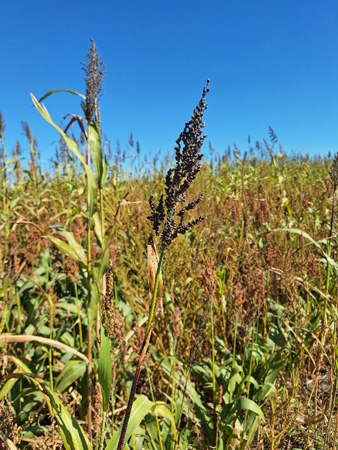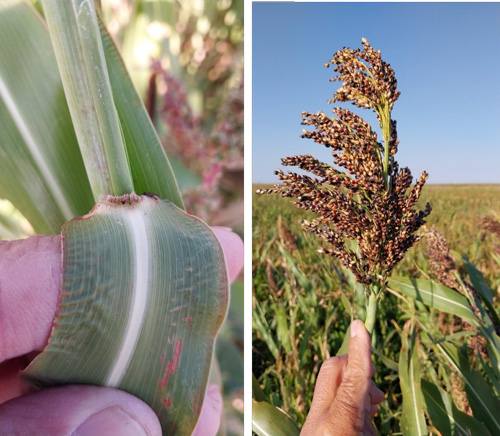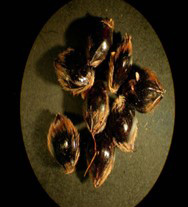This World of Weeds feature is all about shattercane. Shattercane (Sorghum bicolor), sometimes called wild cane or black amber, is the same species as our domesticated sorghums (Figure 1). Some authorities give it the subspecies name drummondii to distinguish it from our cultivated varieties (subsp. bicolor), though the taxonomy of this genus is often debated1. What is certain, though, is that shattercane easily cross-pollinates with cultivated sorghums via insects and wind-dispersed pollen and also cross-pollinates with its weedy relative johnsongrass (Sorghum halapense).

Figure 1. Shattercane growing in a sorghum field. Photo by Sarah Lancaster, K-State Research and Extension.
Ecology
A native of Africa, this species is now widespread in areas of the world where domesticated grain or forage sorghums are grown. It is possible that sorghum arrived in the U. S. as early as the 1600s, but reliable records indicate that several documented introductions occurred in the early 1800s. Shattercane can be utilized by livestock as a forage, but it can accumulate toxic nitrates and prussic acid under certain conditions. Undigested seeds can be spread in manure applied to fields. Shattercane seeds can also be buoyant, allowing for dispersal in moving water. Birds and small mammals utilize its seeds. Shattercane is a host species for disease and insect pests of sorghum and corn. Yield losses from shattercane interference can be as high as 70% in corn and greater than 95% in soybeans.
Identification
Shattercane is a warm-season plant growing up to 12 feet tall. The plant is quite variable in growth habits and tolerant of both heat and drought. The stems are unbranched, but the plant tillers at the base to form clumps. The leaves are generally smooth and display a prominent midrib. They can be up to 20 inches long and 2 inches wide. It has a short membranous ligule with a fringe of hairs at the top (Figure 2). The inflorescence is typically a loose panicle with several pendulous (drooping) racemes (branches). Seeds are dark brown and typically covered with deep purple to black chaff (Figure 3). The panicles, which can number from one to six per plant, produce between 500 and 1500 seeds each. A special layer of abscission cells at the base of the seeds allows them to easily dislodge (shatter) at maturity, giving the plant its common name.

Figure 2. Left: ligule of shattercane - note the prominent midrib (white stripe) seen in the leaf. Right: mature shattercane panicle. Photos by Patrick Geier, K-State Research and Extension.

Figure 3. A close-up of the seed shows the dark-colored chaff. Photos courtesy University of Missouri.
Management
Shattercane control in soybean, sunflower, or cotton begins with a foundation treatment of a Group 3 herbicide such as pendimethalin (Prowl, others). Products containing sulfentrazone (Authority, Spartan, others), a Group 14 herbicide, may also be used in soybeans for partial shattercane control. Group 1 postemergence herbicides such as quizalofop (Assure II, others) or clethodim (Select, others) are very effective for controlling shattercane in broadleaf crops. Where applicable, the Group 10 herbicide glyphosate (Roundup, others) provides excellent shattercane control in glyphosate-resistant crops. Glufosinate (Liberty, others) can also provide good shattercane control in resistant cultivars. Some of the ALS herbicides (Group 2), such as imazethapyr (Pursuit, others), may also control shattercane; however, confirmed resistance to the Group 2 herbicides is well documented in Kansas.
In corn, preemergence options for shattercane generally consist of premixes containing Group 5 (atrazine, others), Group 14 (saflufenacil, others), Group 15 (metolachlor, others), and/or Group 27 (mesotrione, others) herbicides. These products provide fair to good control. Glyphosate-based postemergence herbicides provide excellent control in Roundup-Ready corn, as does quizalofop in Enlist corn. Group 2 herbicides (nicosulfuron, others) can also be effective, provided the shattercane is not a resistant biotype.
Grain and forage sorghum crops provide a unique challenge when managing shattercane. Although some of the premixes listed above for corn are used in sorghum, none is very effective against shattercane. New herbicide-resistant grain or forage sorghum hybrids may come to mind as an option for postemergence control of shattercane. However, shattercane is NOT listed as a weed controlled by the herbicides quizalofop (sold as FirstAct for Double Team hybrids) and imazamox (sold as Imiflex for igrowth hybrids). Farmers who use these technologies must follow the herbicide stewardship guidelines regarding shattercane and johnsongrass on the herbicide labels to slow the development of herbicide resistance. Challenges associated with chemical control of shattercane in grain and forage sorghum mean other management tactics are required. These include starting with a weed-free seedbed (using a burndown herbicide or light tillage to destroy weeds) or planting after the first flush of shattercane has emerged and can be controlled. Narrow row spacing and dense crop canopies will inhibit weed emergence.
Finally, prevent the spread of shattercane seeds by harvesting infested fields last (where possible), thoroughly cleaning harvest equipment before moving to a new field, and controlling shattercane in ditches and roadways. These cultural control methods are good integrated weed management practices regardless of which crop is being grown.
References:
1 DeFelice, M. S. 2006. Shattercane, Sorghum bicolor (L.) Moench ssp. drummondii (Nees ex Steud.) de Wet ex Davidse – black sheep of the family. Weed Technol. 20:1076-1083.
Sarah Lancaster, Extension Weed Management Specialist, Manhattan
slancaster@ksu.edu
Patrick Geier, Weed Scientist, Garden City
pgeier@ksu.edu